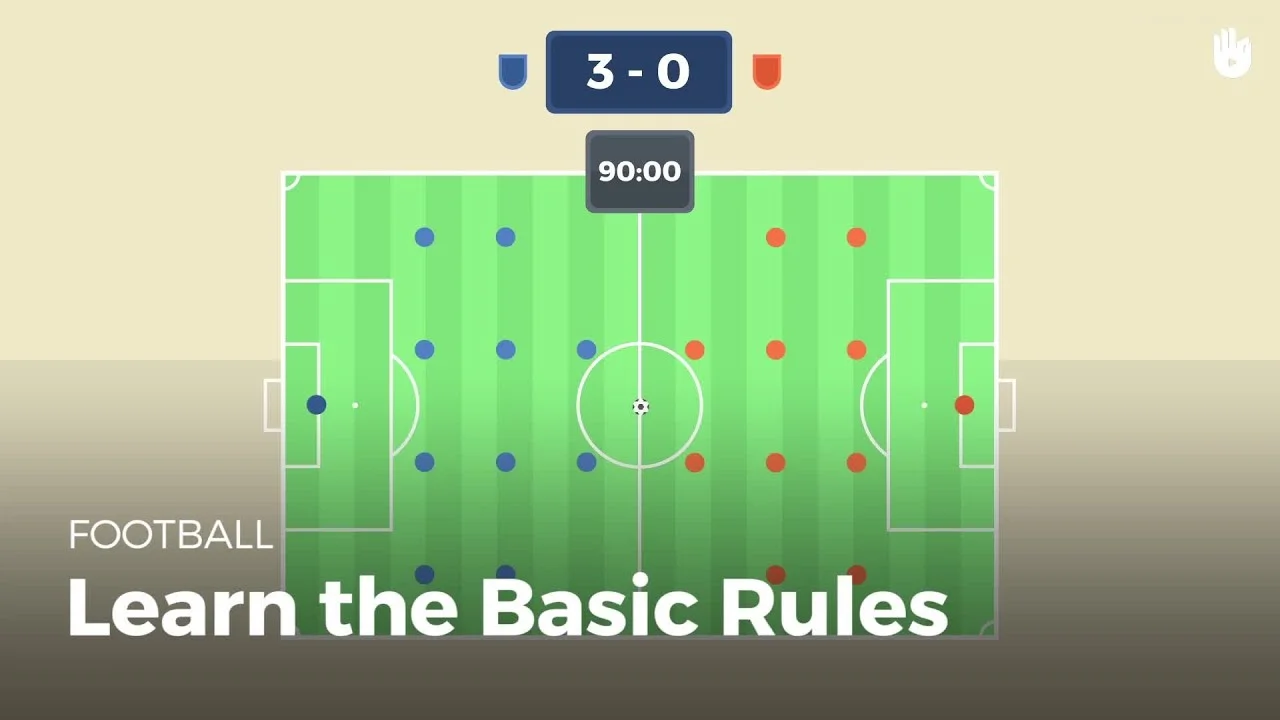What Are the Rules of Football? A Comprehensive Guide to the Laws of the Beautiful Game

Football, known as soccer in some parts of the world, is one of the most popular sports globally, with millions of fans and players. The game is simple in essence—two teams compete to score the most goals within a given time frame. However, it’s governed by a set of specific rules, known as the Laws of the Game, established by the International Football Association Board (IFAB). These laws not only ensure fair play but also help maintain the integrity and spirit of the game.
Table of Contents
In this comprehensive guide, we will explore the key rules of football, from the basics like the number of players to more nuanced aspects such as offside, fouls, and penalties. Whether you’re a casual fan, a budding player, or someone looking to deepen your understanding of the sport, this article will provide a clear breakdown of football’s fundamental rules.
1. The Objective of the Game
At its core, the primary objective in football is to score more goals than the opposing team. Each team has 11 players, including a goalkeeper, and they try to move the ball into the opposition’s goal using any part of their body except their hands and arms (goalkeepers are the exception to this rule). The team with the most goals at the end of the match is declared the winner. If the scores are tied, the game may end in a draw or proceed to extra time or a penalty shootout, depending on the competition format.
2. The Field of Play
The field of play in football is a rectangular grass or artificial turf field with specific dimensions:
- Length: Between 100 and 130 yards
- Width: Between 50 and 100 yards
The field is marked with boundaries, including two goal lines and two touchlines, along with markings for the center circle, penalty areas, and goal areas. Each goal is 8 feet high and 8 yards wide, and they are positioned at the center of each goal line.
3. The Ball
The ball used in football must meet specific criteria:
- Shape: Spherical
- Material: Leather or other suitable material
- Circumference: Between 27 and 28 inches
- Weight: Between 14 and 16 ounces
The ball must be of the correct size and weight for official matches, and if the ball becomes defective, the match is stopped, and a new ball is introduced.
4. The Number of Players
A standard football match is played between two teams of 11 players each, including a goalkeeper. A match cannot start if either team has fewer than 7 players. Substitutes are allowed, and the number of substitutions varies depending on the competition rules (typically 3-5 substitutions per team per match).
Goalkeeper’s Role:
The goalkeeper is the only player allowed to handle the ball within the penalty area. Their primary role is to prevent the opposing team from scoring by blocking shots on goal.
5. Duration of the Match
A football match consists of two 45-minute halves, making a total playing time of 90 minutes. There is a 15-minute halftime interval between the two halves. If the match requires a winner (such as in knockout stages of tournaments), and the score is tied at the end of regular time, the match may go to:
- Extra Time: Two 15-minute halves
- Penalty Shootout: If the score remains tied after extra time, a penalty shootout determines the winner.
6. The Start and Restart of Play
- Kickoff: The game begins with a kickoff, where one team kicks the ball from the center of the field after the referee’s whistle. Kickoffs also occur at the start of the second half and after each goal is scored.
- Throw-In: If the ball goes out of play over the touchline, the opposing team is awarded a throw-in, which must be taken with both hands over the head and both feet on the ground.
- Goal Kick: A goal kick is awarded when the ball crosses the goal line, last touched by an attacking player, but no goal is scored.
- Corner Kick: A corner kick is awarded when the ball crosses the goal line, last touched by a defending player, and no goal is scored.
7. The Offside Rule
The offside rule is one of the most complex and frequently debated rules in football. A player is considered offside if, at the moment the ball is passed to them, they are nearer to the opponent’s goal line than both the ball and the second-to-last defender (not counting the goalkeeper), unless they are in their own half.
- Not Offside: A player is not offside if they are level with the second-to-last defender, receive the ball directly from a throw-in, corner kick, or goal kick, or are in their own half.
- Offside Infringement: If a player is deemed to be offside, the opposing team is awarded an indirect free kick from the position where the offside occurred.
8. Fouls and Misconduct
Football is a contact sport, but there are strict rules governing player conduct to ensure safety and fairness.
- Direct Free Kick: Awarded when a player commits a serious foul, such as kicking, tripping, pushing, or handling the ball deliberately. A direct free kick means the ball can be shot directly at goal.
- Indirect Free Kick: Given for less serious offenses like dangerous play, or when a goalkeeper handles a back-pass from a teammate. The ball must be passed before a shot is attempted.
- Penalty Kick: Awarded if a player commits a direct free kick offense inside their own penalty area. A penalty kick is taken from the penalty spot, 12 yards from the goal, with only the goalkeeper allowed to defend.
- Yellow Card: Given as a warning for unsporting behavior, dissent, or repeated fouls. Two yellow cards in a match result in a red card.
- Red Card: Results in immediate dismissal from the match. A red card can be shown for violent conduct, serious foul play, or receiving two yellow cards. A team must continue with fewer players if a player is sent off.
9. Free Kicks and Penalties
- Free Kicks: Free kicks can be either direct or indirect. A direct free kick allows the ball to be shot directly into the goal without it touching another player, while an indirect free kick requires the ball to touch another player before a goal can be scored.
- Penalty Kick: Taken from the penalty spot and is awarded for a foul committed by a defending player in their own penalty area. The kicker must only face the goalkeeper, and the kick must be taken after the referee’s signal.
10. The Role of the Referee and Assistant Referees
The referee is the ultimate authority during a football match. Their primary duties include enforcing the Laws of the Game, starting and stopping the match, and making decisions on fouls, free kicks, penalties, and misconduct. The referee is assisted by two assistant referees (linesmen), who help judge offside decisions and monitor the ball going in and out of play.
In higher levels of football, such as professional leagues and international tournaments, VAR (Video Assistant Referee) is used to review decisions in real-time, ensuring that critical decisions are fair.
11. Scoring Goals and Winning the Match
A goal is scored when the entire ball crosses the goal line between the goalposts and beneath the crossbar, provided no fouls or infringements have occurred in the lead-up to the goal.
- Winning the Match: The team with the most goals at the end of the match wins. If both teams score the same number of goals, the match is a draw unless a winner must be determined, in which case extra time or a penalty shootout may follow.
12. Football Tactics and Strategies
Although the Laws of the Game provide the framework, football is also about tactics and strategies employed by teams. Coaches often adapt formations (such as 4-4-2, 3-5-2, or 4-3-3) to their team’s strengths and the opposition’s weaknesses. Players are assigned specific roles—such as defending, playmaking, and goal-scoring—based on the team’s tactics.
13. Goal-Line Technology and VAR
In modern football, technology has become an integral part of officiating. Goal-line technology ensures that goals are accurately judged, preventing disputes over whether the ball crossed the line. VAR (Video Assistant Referee) helps referees review key decisions such as penalties, red cards, and offside calls to reduce human error and improve fairness in the game.
Conclusion
Football’s rules may seem straightforward on the surface, but the game is governed by a detailed and well-structured set of regulations designed to maintain fairness, safety, and excitement on the field. The Laws of the Game, established by IFAB, have evolved over time to meet the demands of the modern game, but their core purpose remains the same: to ensure a fair contest between two teams as they compete to score goals.
Understanding the rules, from the offside law to penalty kicks, is essential for players, coaches, and fans alike. Whether you’re playing in a local league or watching the World Cup, these rules shape every match, making football the beautiful game loved by millions across the world.



